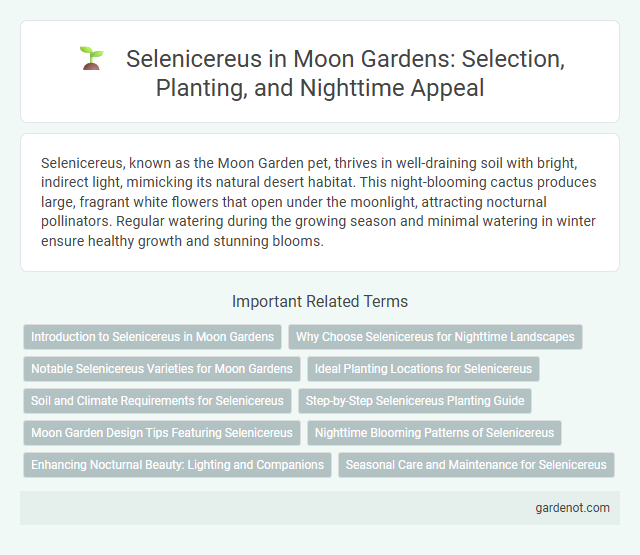Selenicereus, known as the Moon Garden pet, thrives in well-draining soil with bright, indirect light, mimicking its natural desert habitat. This night-blooming cactus produces large, fragrant white flowers that open under the moonlight, attracting nocturnal pollinators. Regular watering during the growing season and minimal watering in winter ensure healthy growth and stunning blooms.
Introduction to Selenicereus in Moon Gardens
Selenicereus, known for its spectacular nocturnal blooms, thrives in Moon Gardens by creating an enchanting nighttime display with large, fragrant flowers that open after sunset. This cactus genus, native to tropical and subtropical regions, enhances Moon Gardens by attracting nocturnal pollinators like moths and bats, contributing to the ecosystem's biodiversity. Its sprawling growth habit and distinctive ribbed stems provide structural interest and complement the serene, mystical ambiance typical of Moon Gardens.
Why Choose Selenicereus for Nighttime Landscapes
Selenicereus is an ideal choice for nighttime landscapes due to its striking nocturnal blooms that emit a captivating fragrance, attracting pollinators like moths and bats under moonlight. Its hardy succulent stems require minimal water, making it perfect for sustainable moon gardens in arid climates. The dramatic, large white flowers create an ethereal visual effect in low-light settings, enhancing garden aesthetics after dark.
Notable Selenicereus Varieties for Moon Gardens
Selenicereus varieties such as Selenicereus grandiflorus, known for its large, fragrant white blooms, are ideal for moon gardens that emphasize nocturnal beauty. The Selenicereus megalanthus features striking yellow flowers that open at night, creating vibrant contrasts under moonlight. Cultivating these notable species enhances the ethereal ambiance of moon gardens by attracting night pollinators like moths and bats.
Ideal Planting Locations for Selenicereus
Selenicereus thrives in warm, humid environments with well-draining soil and partial shade, making it ideal for tropical and subtropical gardens. These night-blooming cacti prefer locations protected from direct midday sun to prevent stem scorch, such as under the canopy of taller trees or on shaded patio areas. Planting Selenicereus near trellises or fences supports their climbing nature and maximizes blooming potential.
Soil and Climate Requirements for Selenicereus
Selenicereus thrives in well-draining, sandy or loamy soil with a slightly acidic to neutral pH of 6.0 to 7.0, ensuring roots do not remain waterlogged. This cactus prefers warm, humid climates with temperatures ranging from 60degF to 90degF (16degC to 32degC) and requires protection from frost and prolonged cold. Bright, indirect sunlight and moderate watering during the growing season are essential for optimal growth and flowering.
Step-by-Step Selenicereus Planting Guide
Selenicereus, commonly known as the Moon Garden cactus, thrives in well-drained soil with a mix of cactus potting medium and perlite for optimal growth. Begin by selecting a healthy cutting, allowing the cut end to callous for 1-2 weeks before planting to prevent rot. Plant the cutting in a shaded area with indirect light, maintain moderate moisture, and gradually increase sunlight exposure to encourage strong root development and vibrant flowering.
Moon Garden Design Tips Featuring Selenicereus
Selenicereus, a striking cactus species known for its large, fragrant night-blooming flowers, is an ideal centerpiece for a moon garden design due to its nocturnal beauty and low maintenance. Incorporate Selenicereus with silvery foliage, white or pale-colored blossoms, and surrounding reflective surfaces like white stones or light-colored gravel to enhance moonlight reflection and create a tranquil nighttime ambiance. Position this climber near trellises or pergolas where its sprawling stems can thrive while optimizing space and adding vertical interest to the moon garden.
Nighttime Blooming Patterns of Selenicereus
Selenicereus, known as the moon garden cactus, exhibits unique nighttime blooming patterns triggered by darkness and cooler evening temperatures. Its large, fragrant flowers open rapidly after sunset and typically last through the night, attracting nocturnal pollinators such as moths and bats. This adaptive blooming strategy enhances reproductive success in arid environments where daytime pollinator activity is limited.
Enhancing Nocturnal Beauty: Lighting and Companions
Selenicereus, known as the moonlight cactus, enhances nocturnal garden beauty with its large, fragrant blooms that open only at night. Strategic lighting, such as soft LED spotlights, highlights its delicate flowers and dramatic cactus silhouette, creating a mystical ambiance. Companion plants like white-flowered night-blooming jasmine or silver-leafed Artemisia amplify the moon garden's ethereal glow and attract nighttime pollinators.
Seasonal Care and Maintenance for Selenicereus
Selenicereus thrives with precise seasonal care, requiring increased watering and consistent humidity during the active growing season from spring to early fall. Pruning after flowering encourages healthy growth and prevents overcrowding, while reducing water intake and halting fertilization in winter supports its dormancy. Maintaining temperatures above 50degF (10degC) and ensuring indirect sunlight optimizes blooming and overall plant vitality.
Selenicereus Infographic

 gardenot.com
gardenot.com